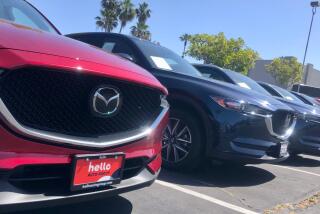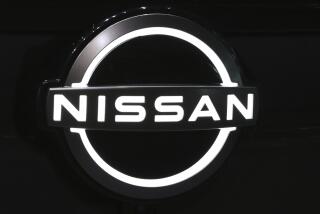Auto Makers to Issue Warning on Air Bag Peril
- Share via
DETROIT — As evidence grows about the dangers of air bags, the Big Three U.S. auto makers announced Friday that they will send letters to 22 million vehicle owners alerting them that the safety devices can maim and kill children.
Air bags have killed 47 individuals, including 29 young children and infants, since 1990. The death toll is rising sharply as more vehicles are being equipped with the devices--particularly on the passenger side, where children are often seated. Fourteen children have been killed by air bags this year alone.
The industry’s move casts a dramatic spotlight on the cruel irony of the air bag. Even as the devices are harming more and more defenseless children, they are credited with saving far more lives--about 1,100 to date.
“Air bags have reduced fatalities,” said Andrew Card, president of the American Automobile Manufacturers Assn., a lobbying group for Chrysler Corp., Ford Motor Co. and General Motors Corp.. “But there have been infrequent but serious adverse effects as a result of air bags.”
The response of the industry and the government to air bags’ unintended effects has generally been to attempt to educate motorists, make today’s bags less dangerous and accelerate research into “smart” air bags whose deployment can be customized to fit the circumstances.
In addition to the rare mass mailing, the auto makers will begin adding prominently displayed warning labels to all new vehicles equipped with air bags, instructing parents to place infants and young children in the back seat when possible. The language of the labels has not been decided. Warning labels are now included in owner’s manuals and unobtrusively on car visors.
The Big Three also said they will introduce vehicles in Canada next fall with air bags that don’t inflate as rapidly as the current ones. The high speed of deployment--up to 200 mph--was a crucial factor in most of the injuries and deaths.
The industry has asked government permission to do the same thing in the United States, but federal safety rules must be changed to allow the use of the less aggressive air bags here. The National Highway Traffic Safety Administration is expected to rule on the request in a few weeks.
NHTSA administrator Ricardo Martinez on Friday applauded the actions taken by the domestic auto makers. “We encourage other car companies to join in this effort,” he said.
*
The Assn. of International Automobile Manufacturers, which represents Japanese, German and other foreign-based car makers, said its members were in general agreement with the Big Three’s actions and are in the process of individually implementing similar steps.
The U.S. auto makers’ action comes 11 days after parents of children killed by air bags met with NHTSA officials in an emotional meeting and demanded that the industry be forced to alert vehicle owners of the dangers of air bags.
“We commend the industry for what they did today,” said Richard Sanders, a Baltimore attorney whose daughter was killed a year ago by an air bag. “At the same time we say it is coming too late. Thirty children have already been killed.”
Air bags deploy in 30 to 50 milliseconds--faster than a blink of an eye. The force is so strong that it can seriously injure small individuals, particularly infants in rear-facing child seats or improperly belted children younger than 13. The fatal injuries to children are gruesome, often involving broken necks and severe head injuries.
There is growing evidence that even properly belted children can be in danger from air bags. Last month, the government confirmed for the first time that a properly belted 5-year-old in Tennessee was killed by an air bag. And this week, the death of a fetus was attributed to an air bag that deployed in front of a pregnant woman.
In addition, 18 adult drivers--mostly small women or elderly individuals who sit close to the steering wheel, where the air bag is contained--have been killed by the bags. Many of the deaths occurred in low-speed accidents that would not have caused serious injury had the air bags not deployed.
Still, government regulators said air bags save lives. The NHTSA estimates that air bags have saved more than 1,100 lives since 1986.
The industry has been phasing in air bags since 1990. Today, there are 48 million cars on U.S. highways equipped with driver-side air bags. Of those, 22 million also have passenger-side air bags.
Air bag fatalities are the latest twist in a tortuous battle over the safety devices, which began more than 25 years ago. In the 1970s, auto makers fought air bags, saying they could cause injury and were too expensive.
In 1984, then-Transportation Secretary Elizabeth Hanford Dole ordered that 1990 vehicles must have either automatic seat belts or air bags. Consumers disliked the automatic belts, and air bags were embraced by the industry after then-Chrysler Chairman Lee Iacocca--a longtime air bag critic--ordered them installed as standard equipment on some Chrysler vehicles.
In 1991, President Bush signed a law requiring driver and passenger air bags in all new cars by September 1997, and in all new trucks a year later.
As dramatic testimonials documented that the bags were saving lives in horrible crashes, motorists began demanding the devices. They became a marketing tool as auto makers competed to add driver, passenger and now side air bags.
*
But as the use of devices expanded, regulators and the auto companies saw an increase in air bag-related injuries and deaths.
By 1995 the NHTSA was urging auto makers to send letters to consumers about air bag dangers, but the companies resisted. The agency continued to investigate the problem and in August proposed changes to its air bag regulations.
The NHTSA said auto makers should be required to put prominent warning labels in their vehicles unless they install “smart” air bag systems designed to protect young children from injuries caused by inflating air bags.
These more-sophisticated systems can detect the presence and position of small children in the front passenger seat and automatically deactivate the air bag or deploy it at a slower, less dangerous speed.
The auto makers are working on smart air bags, but industry officials said it will be at least three to five years before reliable, affordable devices are ready.
As research and development continues, the Big Three have petitioned the NHTSA to rewrite federal safety regulations to allow less aggressive air bag deployment. The rules are now written to protect an unbelted 165-pound man in a 30-mph frontal crash.
When the regulation was adopted, seat-belt use in the United States was only about 10%. It is now about 67%. The auto makers feel that the rule should be altered to protect belted passengers. That, in turn, would allow a 25% reduction in deployment speed.
But it is more complex than that. Slower deployment might reduce injuries to children, but it could also endanger more unbelted passengers in severe accidents.
“I’m concerned about depowering the air bag,” said Joan Claybrook, president of the consumer advocacy group Public Citizen and a former NHTSA administrator. “We don’t want to harm more people in high-speed crashes.”
In the United States, federal regulators are considering letting auto makers install cutoff switches to allow manual shut-off of passenger-side air bags when a child is present. Ford has already installed the feature on some pickup trucks that have no back seat.
But auto makers and consumer advocates do not see this as a long-term solution because a driver could forget to turn the air bag back on, endangering a passenger in a crash.
(BEGIN TEXT OF INFOBOX / INFOGRAPHIC)
Air Bag Danger
Safety Tips
The blast of energy--up to 200 mph--that inflates the bag can crush a passenger positioned too close to the bag as it deploys. Here are some tips for drivers with young passengers:
* In general, any child under 12 should ride in back seat.
* A rear-facing car seat should not be used in the front seat of a car with a passenger-side air bag.
* For all passengers, shoulder and lap belts must be worn at all times. Without proper shoulder restraint, the passenger is flung forward into the air bag as it is expanding and can be struck with enough force to cause serious or even fatal injury.
* A child should ride in a car seat or booster until he or she is tall enough for the shoulder belt to fit properly across the chest.
* Owner’s manuals carry additional information on proper installation and use of child seat belts, safety seats and air bags.
Sources: National Highway Traffic Safety Administration, Insurance Institute for Highway Safety; compiled by ROB CIOE / Los Angeles Times






